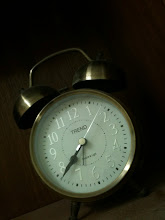This is the suggested template for interpretation of a chest X-ray. I am not sure whether we will be asked to present the interpretation of CXR verbally during OSCE or not. But it is important especially for junior HOs (of which I am going to become soon, God willing) to master the skill in order to communicate with the consultant as well as senior HOs and MOs regarding the findings.
Systematic approach
1) Patient's details: Name, age, gender
2) Film details: Date taken, projection (PA, AP, Left or right lateral), whether it is a single film or one of a series.
3) Technical details: Rotation (if rotated, one can't comment on cardio-thoracic ratio), Inspiration (count the ribs), Penetration (good = able to see pedicles of spine)
4) Heart: Size (Cardio-thoracic ratio), Border (from aortic knuckle and work round to superior vena cava)
5) Trachea: Central or deviated
6) Lungs: Hilar (size, level, any congestion?) ; Fields (use 'zones' instead of 'lobes')
7) Diaphragm: flattened or normal? Costophrenic and costocardiac angles - blunted/loss, normal
8) Mediastinum: size and shape
9) Bones: Including humerus, clavicle, scapula, and ribs.
Some clinicians prefer to describe the CXR 'inside-out' while others prefer the other way round. It's up to us to choose, depending on our preference. Do practice on describing the CXR using this format so that we won't be having "verbal constipation" as one of my lecturers had mentioned in one of his book(s). All the best~ (to myself as well)
p.s. I would like to suggest you to read up Chest X-Ray Made Easy book in order to help you to grasp the knowledge and skills required. Plus, never miss the Radiology classes and make sure you are giving your attention to the fullest because some of the radiographs might be used for OSCE examination. Or at least the ones similar to those. And please get use to the terminology used in describing a radiograph, such as consolidation, opacity, honey-comb appearance, etc.
Systematic approach
1) Patient's details: Name, age, gender
2) Film details: Date taken, projection (PA, AP, Left or right lateral), whether it is a single film or one of a series.
3) Technical details: Rotation (if rotated, one can't comment on cardio-thoracic ratio), Inspiration (count the ribs), Penetration (good = able to see pedicles of spine)
4) Heart: Size (Cardio-thoracic ratio), Border (from aortic knuckle and work round to superior vena cava)
5) Trachea: Central or deviated
6) Lungs: Hilar (size, level, any congestion?) ; Fields (use 'zones' instead of 'lobes')
7) Diaphragm: flattened or normal? Costophrenic and costocardiac angles - blunted/loss, normal
8) Mediastinum: size and shape
9) Bones: Including humerus, clavicle, scapula, and ribs.
Some clinicians prefer to describe the CXR 'inside-out' while others prefer the other way round. It's up to us to choose, depending on our preference. Do practice on describing the CXR using this format so that we won't be having "verbal constipation" as one of my lecturers had mentioned in one of his book(s). All the best~ (to myself as well)
p.s. I would like to suggest you to read up Chest X-Ray Made Easy book in order to help you to grasp the knowledge and skills required. Plus, never miss the Radiology classes and make sure you are giving your attention to the fullest because some of the radiographs might be used for OSCE examination. Or at least the ones similar to those. And please get use to the terminology used in describing a radiograph, such as consolidation, opacity, honey-comb appearance, etc.





No comments:
Post a Comment